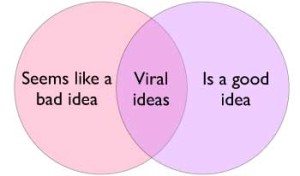 I’ve been reading Nate Silver’s book The Signal and the Noise
I’ve been reading Nate Silver’s book The Signal and the Noise. Nate Silver, in case you haven’t seen him on one of the 20 or so talk shows he’s been on to publicize his book, is the statistician who correctly predicted the winner of the electoral vote in all fifty states in 2012 (49 out of 50 in 2008). He also correctly predicted 31 of 33 Senate races (he predicted two Senate races for Republicans that were won by the Democrats). There are some interesting lessons in the book for marketers, including the question, are you a fox or a hedgehog?
A Fox or a Hedgehog?
The concept comes from an Isaiah Berlin essay on the Russian novelist Leo Tolstoy, and goes even further back to a quote attributed to the Greek poet Archilochus:
The Fox knows many things, but the hedgehog knows one big thing
Silver applies this concept to political discourse, and describes partisan television pundits as hedgehogs, people who tend to see the world through their “big ideas” about the role of government, the effect of taxes on the economy, etc. Foxes, in Silver’s words, are “scrappy creatures who believe in a plethora of little ideas and in taking a multitude of approaches toward a problem.” In case you haven’t guessed, Silver sees himself as a fox. He offers evidence that foxes make better predictions because they are more willing to consider multiple points of view, and they are less likely to view everything through their partisan lens.
Here is a table from Silver’s book describing the differing attitudes of foxes and hedgehogs.
| How Foxes Think | How Hedgehogs Think |
| Multidisciplinary: Incorporate ideas from different disciplines regardless of their origin on the political spectrum | Specialized: Often have spent the bulk of their careers on one or two great problems. May view the opinions of “outsiders” skeptically. |
| Adaptable: Find a new approach – or pursue multiple approaches at the same time – if they aren’t sure the original one is working. | Stalwart: Stick to the same “all-in” approach – new data is used to refine the original model. |
| Self-critical: Sometimes willing (if rarely happy) to acknowledge mistakes in their predictions and accept the blame for them. | Stubborn: Mistakes are blamed on bad luck or on idiosyncratic circumstances – a good model had a bad day. |
| Tolerant of complexity: See the universe as complicated, perhaps to the point of many fundamental problems being insolvable or inherently unpredictable. | Order-seeking: Expect that the world will be found to abide by relatively simple governing relationships once the signal is identified through the noise. |
| Cautious: Express their predictions in probabilistic terms and qualify their opinions. | Confident: Rarely hedge their predictions and are reluctant to change them. |
| Empirical: Rely more on observation than theory. | Ideological: Expect that solutions to many day-to-day problems are manifestations of some grander theory or struggle. |
What do Hedgehogs and Foxes have to do with Marketing?
Traditionally, most marketers have been hedgehogs. They look for the big idea, the big campaign and express their vision of the future with confidence, rather than in probabilistic terms. Many marketers are like the pundits on television: entertaining, quick on their feet and quick to blame failures on “bad luck”.
But if we’re going to take an Agile Marketing approach, moving forward in small steps, and relying on observation and measurement to adjust our approach, we need to act more like foxes. We need to incorporate ideas from different disciplines, regardless of their origin. We need to be tolerant of complexity, and be aware that customers don’t always, or even usually, fit into our neat little buckets. We need to be adaptable – adjusting our approach quickly as we’re presented with new data. In short, we need to be foxes.
Nate Silver suggests several principles which should help us be more “foxy”.
Principle 1: Prepare For a Range of Possible Outcomes
Silver refers to this as probabilistic thinking. Too often, we only prepare for the most likely outcome. But what if several outcomes are possible: the most likely has a 40% chance of occurring, another has a 30% chance of occurring and a third has a 25% chance of occurring. The remainder are outliers. Marketers who present six-month marketing plans want to appear confident, not seem like they’re hedging or uncertain. And so they might present the most probable outcome as their prediction, even though the math says that there is a 60% likelihood of a different outcome. Sometimes we really don’t know, and it’s better to prepare for that range of outcomes.
Principle 2: Don’t Hold On to the Past
Often, we’re reluctant to change our approach or our predictions because yesterday we were heavily invested in a different approach or a different prediction. But Silver encourages us to “make the best forecast possible today“. There’s no glory in being consistent and wrong. If the facts change, or we have information that we didn’t have the day before, the brave thing to do is to acknowledge this, and take a different approach or make a different prediction of the behavior of the market.
Some might see this as a sign of weakness, and certainly if our approach or our predictions are all over the map, changing daily, that’s a problem. But as John Maynard Keynes said when he was accused of changing his position on monetary policy in response to the Great Depression:
When my information changes, I alter my conclusions. What do you do, sir?
Principle 3: Look at Multiple Perspectives
Silver notes that the evidence suggests that group forecasts are more accurate than individual forecasts. The reason for this is not the supposed wisdom of crowds, but that group forecasts “benefit from applying multiple perspectives toward a problem”.
As marketers, we need to be open to multiple perspectives. Rather than creating the one big-bang campaign that is going to blow everyone away, sometimes we can be more successful creating mini-campaigns, targeting very specific segments of our market. This has certainly been the lesson of keyword marketing, where the use of slightly less popular long-tail keywords can often be more effective than paying a very high CPC for the single most popular keyword.
Principle 4: Beware Magic Bullets
Internet marketers thrive by offering magic bullet techniques that are going to make us rich. But too often, the only person getting rich is the internet marketer with the not-so-magic bullet. Generally, there are no magic bullets, and good marketing takes skill and hard work. Recognize this, and invest for the long term.
What do you think? Are you a fox or a hedgehog? We probably need a mix, but perhaps with Agile Marketing, we need a few more foxes.




Fantastic article. Thanks for sharing it. I think, and hope, I have more Fox like thinking patterns but cant be sure.
Jim, thanks for the kind words. Silver says that foxes are distinguished by better predictions when they have more information, whereas hedgehog’s predictions actually get worse with more information. There is some academic work that supports this from a guy named Philip Tetlock https://www.psych.upenn.edu/node/20543
Fantastic article. Thanks for sharing it. I think, and hope, I have more Fox like thinking patterns but cant be sure.
Jim, thanks for the kind words. Silver says that foxes are distinguished by better predictions when they have more information, whereas hedgehog’s predictions actually get worse with more information. There is some academic work that supports this from a guy named Philip Tetlock https://www.psych.upenn.edu/node/20543
Interesting article, thank you!! I have written a blog post about the same thing but in this case related to social media. Here I have considered the benefits of the hedgehog in terms of jumping right into “it” with a self confidence and passion that gives faster results than the approach of the fox… ; ) https://jluytkis.wordpress.com/2011/11/18/hello-world/
Jeannette, thanks for bringing this to my attention. I read Good to Great perhaps 10 years ago, but had forgotten his use of the analogy. Isn’t it interesting how people celebrate one or the other, hedgehog or fox? Jim Collins is clearly a hedgehog, Nate Silver a fox, and they read different things into the analogy. Truth is, you need both. Happy Thanksgiving.
Hi Jim and thank you for your comment! Good to know that there is room for both the hedgehog and the fox in this world! : ) Have you read any Machiavelli and about Power? He stated that the one with the most power is the one who uses both the fox and in this case the lion’s attributes to get results. Also an interesting approach. Have a nice day! : )
It’s a long time since I read Machiavelli; probably not since college. Thanks for mentioning. I’ll take a look at it.
Interesting article, thank you!! I have written a blog post about the same thing but in this case related to social media. Here I have considered the benefits of the hedgehog in terms of jumping right into “it” with a self confidence and passion that gives faster results than the approach of the fox… ; ) https://jluytkis.wordpress.com/2011/11/18/hello-world/
Jeannette, thanks for bringing this to my attention. I read Good to Great perhaps 10 years ago, but had forgotten his use of the analogy. Isn’t it interesting how people celebrate one or the other, hedgehog or fox? Jim Collins is clearly a hedgehog, Nate Silver a fox, and they read different things into the analogy. Truth is, you need both. Happy Thanksgiving.
Hi Jim and thank you for your comment! Good to know that there is room for both the hedgehog and the fox in this world! : ) Have you read any Machiavelli and about Power? He stated that the one with the most power is the one who uses both the fox and in this case the lion’s attributes to get results. Also an interesting approach. Have a nice day! : )
It’s a long time since I read Machiavelli; probably not since college. Thanks for mentioning. I’ll take a look at it.
hi jim, happy thanksgiving. we have had a good with sunshine outside sunshin inside sarah,J,AND REX and his mother and dan and pamala ho\pe your trip is in sunshine too. we ate the hedgehog. ppg and family by george
George, Happy Thanksgiving. We’ve had a great time here in Manzanita. No hedgehogs though . . .
hi jim, happy thanksgiving. we have had a good with sunshine outside sunshin inside sarah,J,AND REX and his mother and dan and pamala ho\pe your trip is in sunshine too. we ate the hedgehog. ppg and family by george
George, Happy Thanksgiving. We’ve had a great time here in Manzanita. No hedgehogs though . . .
Pingback: Are You a Fox or a Hedgehog? | Agile For Startu...